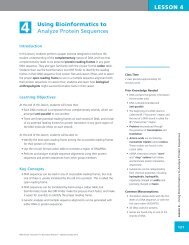WET LAB DNA Barcoding: From Samples to Sequences - Northwest ...
WET LAB DNA Barcoding: From Samples to Sequences - Northwest ...
WET LAB DNA Barcoding: From Samples to Sequences - Northwest ...
Create successful ePaper yourself
Turn your PDF publications into a flip-book with our unique Google optimized e-Paper software.
<strong>WET</strong> <strong>LAB</strong><br />
CLASS SET<br />
Lab 2: Copying the <strong>DNA</strong> <strong>Barcoding</strong> Gene<br />
Using Polymerase Chain Reaction (PCR)<br />
Student Researcher Background:<br />
What is Polymerase Chain Reaction (PCR)?<br />
Polymerase Chain Reaction or “PCR” is a powerful technique used by many scientists <strong>to</strong> amplify (or “copy”)<br />
a particular gene or region of <strong>DNA</strong> in a test tube. Starting with only a few copies of <strong>DNA</strong>, PCR uses the same<br />
basic ingredients as <strong>DNA</strong> replication in the cell and results in billions of copies of your specific gene. All PCR<br />
experiments contain a few vital components:<br />
• A <strong>DNA</strong> template, which is <strong>DNA</strong> used as instructions <strong>to</strong> make more <strong>DNA</strong>. You will use the <strong>DNA</strong> that you<br />
purified in Lab 1 as a template <strong>to</strong> amplify your gene of interest (the <strong>DNA</strong> barcoding gene).<br />
• A <strong>DNA</strong> polymerase, which is an enzyme that assembles new <strong>DNA</strong> molecules. You will use a special kind of<br />
<strong>DNA</strong> polymerase called Taq polymerase <strong>to</strong> copy your gene.<br />
• Forward and reverse primers, or small pieces of <strong>DNA</strong> used <strong>to</strong> start or “prime” <strong>DNA</strong> synthesis, which bind<br />
specifically <strong>to</strong> the 5’ and 3’ sequences on either side of the <strong>DNA</strong> barcoding gene. These primers tell the <strong>DNA</strong><br />
polymerase where <strong>to</strong> start copying your gene.<br />
• Deoxynucleotide triphosphates (dNTPs), which are the building blocks of <strong>DNA</strong>, and are used <strong>to</strong> build the<br />
new <strong>DNA</strong> molecules during your PCR.<br />
• Buffer (usually in a 10X concentrate, which you dilute with pure water) that helps <strong>to</strong> stabilize the pH of the<br />
solution and reproduce the conditions in a cell so that the Taq <strong>DNA</strong> polymerase can function.<br />
Today you will be using PCR beads (Figure 2.1), which<br />
are tiny white beads that contain all the ingredients for<br />
your PCR (freeze-dried or “lyophilized”) except the <strong>DNA</strong><br />
template, primers, and nuclease-free water.<br />
How Do You Know Which Primers <strong>to</strong> Use?<br />
Scientific experiments build on what is already known. In order<br />
<strong>to</strong> make the Taq <strong>DNA</strong> polymerase specifically copy your gene<br />
and not just any piece of <strong>DNA</strong>, you need <strong>to</strong> use primers that<br />
are known <strong>to</strong> bind <strong>to</strong> the <strong>DNA</strong> right next <strong>to</strong> the gene you want<br />
<strong>to</strong> copy. Genetic researchers who use <strong>DNA</strong> barcoding have<br />
developed primers specific for the COI gene. You will be using<br />
these same mixtures of many different primers called primer<br />
pools. Each primer in the primer pool was originally derived<br />
from the <strong>DNA</strong> barcoding sequence from one or more animals.<br />
By using a pool of primers instead of single forward and reverse<br />
primers, we are increasing the likelihood that one or more<br />
primers will work for your species of interest. Your teacher can<br />
help you decide which primer pool <strong>to</strong> use with your sample.<br />
Primer Pool COI-2 is used for mammals, fish, or insects.<br />
Primer Pool COI-3 is used for amphibians and reptiles, and<br />
can also be used for mammals.<br />
Figure 2.1: PCR Bead in a 0.2 ml Tube Compared <strong>to</strong> a 1.7<br />
ml Microfuge Tube.<br />
Primer pools: Collections or mixtures of primers,<br />
usually used in PCR.<br />
Wet Lab – <strong>DNA</strong> <strong>Barcoding</strong>: <strong>From</strong> <strong>Samples</strong> <strong>to</strong> <strong>Sequences</strong><br />
355<br />
©<strong>Northwest</strong> Association for Biomedical Research—Updated Oc<strong>to</strong>ber 2012
















